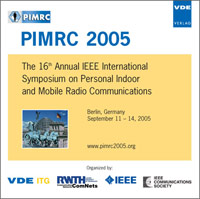Video Rate Control for Streaming and Local Recording Optimized for Mobile Devices
Conference: PIMRC 2005 - 16th Annual IEEE International Symposium on Personal Indoor and Mobile Radio Communications
09/11/2005 - 09/14/2005 at Berlin, Germany
Proceedings: PIMRC 2005
Pages: 5Language: englishTyp: PDF
Personal VDE Members are entitled to a 10% discount on this title
Authors:
Rezaei, Mehdi; Gabbouj, Moncef (Institute of Signal Processing, Tampere University of Technology, Finland)
Wenger, Stephan (Nokia, Research Center, Tampere, Finland)
Abstract:
In this paper we propose a real-time, low-complexity video rate control algorithm designed to obey buffer constraints. The algorithm is optimized for streaming and local recording applications in mobile devices. Today, most mobile phones include a digital camera that can be used to capture video. The on-phone processor technology has become powerful enough to encode video in real-time. The resulting file can, for example, be archived in the phone's memory, or (progressively or as one block) downloaded, through the 3G mobile network, Bluetooth, or WLAN, to Internet-connected computer systems. From here, all forms of multimedia transmission, such as streaming, file sharing, or multimedia mail become possible. In local recording and streaming applications on a mobile phone, we assume that no memory for storage of uncompressed video is available. Therefore, look-ahead and multi-path rate control are not possible. Furthermore, considering the processing power and, more importantly, battery life constraints in mobile devices, the proposed algorithm needs to be as simple as possible. The described algorithm implements a variable bitrate (VBR) by controlling the quantization scale (QS) on a per picture basis. The QS is calculated based on two other QSs, which correspond to constant rate and constant quality rate controls. The algorithm utilizes the variable bitrate benefits as much as possible so as to minimize the variation of the QS scale, and to provide encoded video with high visual quality. Although it strictly obeys buffering constraints as discussed later, the experimental results show that it allows encoded video at average quality levels significantly higher than reported in earlier works.


